Lizards live in deserts, jungles, islands, and continents. The world’s biggest lizards have huge bodies and powerful jaws. Humans admire or dread these reptilian giants depending on culture and location.
These lizards are huge. They may weigh several hundred kilos and measure several meters. Their strong legs and tails enable them to move quickly despite their huge sizes. They can kill enormous prey with their keen claws and strong jaws.
Many of these gigantic lizards are kind, living in peace with their surroundings. Top predators govern animal numbers and preserve environmental equilibrium.
Habitat degradation, poaching, and the illicit pet trade threaten many of these lizards. Critically endangered animals have rapidly declining numbers and uncertain survival.
Despite these obstacles, conservation initiatives are ongoing to preserve these amazing species for future generations. We can protect these species and our planet’s rich biodiversity by increasing awareness of their value and risks.
The largest lizards in the world are amazing and revered. They should be protected and admired as part of our natural heritage. We can protect these amazing creatures for generations by working together. Read about 8 of these species here.
-
Blue Iguana
Average Length: 5 feet
Average Weight: 31 pounds
Estimated Lifespan: 25 – 40 years
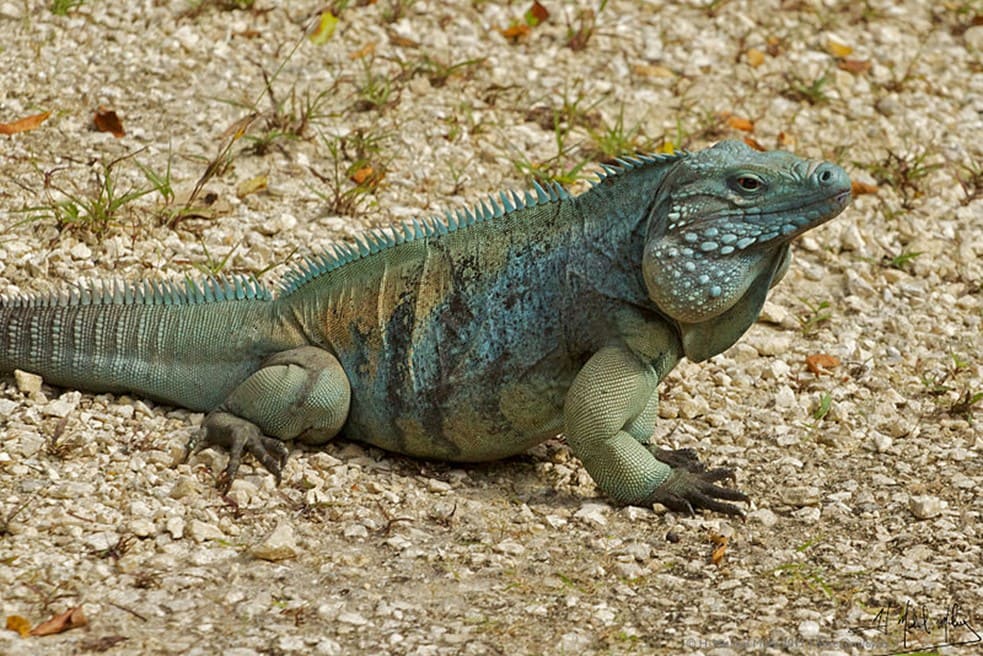 Source: Wikimedia
Source: Wikimedia
This Blue Iguana’s coloration ranges from a deep blue to a bluish-gray, as suggested by its name. It matures to a length of over 5 feet and a weight of roughly 31 pounds. As the iguana hides itself amid the adjacent rocks and brush of Grand Cayman Island, its color helps it blend in more successfully.
This species of lizard has an expected lifetime of between 25 and 40 years and does not reach sexual maturity until between the ages of 4 and 9 years old. They have their young in the spring, usually between the months of April and June.
After mating, the female iguana has the potential to become belligerent and possessive of her territory. The eggs won’t be released from the female until late June or August at the earliest.
She may lay anywhere from 10 to 20 eggs, each of which she will bury one foot underground before tending to for the next 60–90 days until they hatch. There is a significant amount of egg mortality due to the presence of predators.
Did You Know?
The habitat of a versatile lizard may range from dry, rocky forests with prickly foliage to wet sections of wooded forests, arid to subtropical or semi-deciduous forests, or semi-deciduous dry forests.
-
Lace Monitor
Average Length: 6.6 feet
Average Weight: 31 pounds
Estimated Lifespan: 40 years
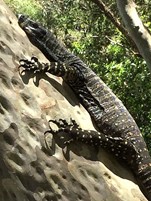 Source: Wikimedia
Source: Wikimedia
The lace monitor, as its name suggests, is dark in tone and has patterns that range from cream to a yellowish-white tint. Because of this, they will be more difficult for their enemies to see.
The female monitor will dig into the side of a termite mound in order to deposit her eggs, which may range in number from 6 to 12. After a period of around seven months, the females will come back to the nest to collect the newly born young.
At a maximum weight of up to 31 pounds, the lace monitor is the second biggest lizard found in Australia. They are able to make greater use of their sense of smell and taste because to the modification of their lengthy tongue into a snake-like shape.
Their lengthy tails are used for a variety of purposes, including maintaining balance when climbing, acting as a whip in self-defense, assisting with swimming, and establishing dominance over females during the mating season.
Did You Know?
They are able to pinpoint the exact location of their enemies by flicking their tongues and tasting the chemical fragments left behind by their prey because to the highly evolved senses they possess. They are dangerous yet not fatal due to their poison.
-
Nile Monitor
Average Length: 7 feet
Average Weight: 33 pounds
Estimated Lifespan: 20 years
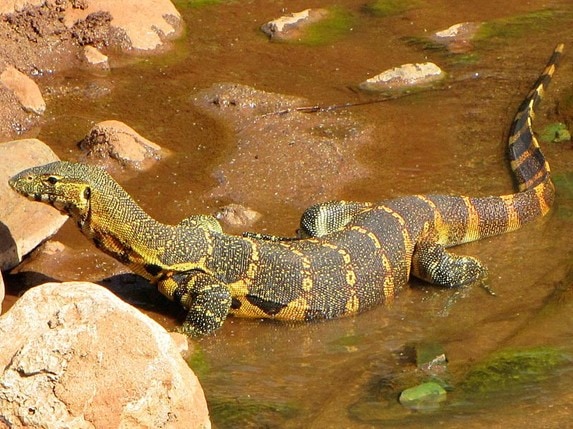 Source: Wikimedia
Source: Wikimedia
The Nile monitor is the sixth-largest species of lizard in our world, with an average weight of 44 pounds and a length of 8 feet. Their bodies range in hue from olive green to black, and their tails are roughly 1.5 times as long as their bodies.
They have V-shaped stripes of cream or yellow color on their heads and necks. When you move your gaze farther down the back, these stripes begin to resemble bands or patches.
As the females reach a length of 14 inches or around two years of age, they will start to have eggs. The number of eggs laid at one time may range anywhere from 12 to 60, and this number is determined by the size of the adult lizard.
They subsist on crabs, crayfish, mussels, snails, slugs, termites, caterpillars, beetles, spiders, grasshoppers, and crickets, fish, frogs, toads, lizards, turtles, snakes, juvenile crocodiles, and other reptiles, birds and their eggs, and small mammals. They also eat young crocodiles.
Did You Know?
While it spends part of its life in the water, the Nile monitor enjoys sunning itself on rocks and tree branches. They are indigenous to Africa and have been seen at altitudes of up to 6,560 feet above the ocean.
-
Black-Throated Monitor
Average Length: 7 feet
Average Weight: 60 pounds
Estimated Lifespan: 25 years
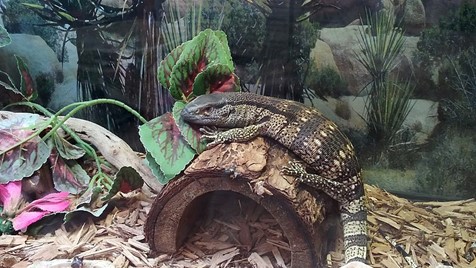 Source: Wikimedia
Source: Wikimedia
This huge lizard is often kept as a pet in people’s homes. When they are brought up as pets, their demeanor is quite placid, and they even need contact with their human caregivers and are claimed to be able to identify their owners.
Individuals who spend their childhoods in the outdoors are more likely to develop aggressive tendencies because of their constant drive to play. When a person is unsure of what they want, it might make them anxious, which can lead to aggressive behavior.
These lizards may reach lengths of up to 7 feet and weights of up to 60 pounds. Their scales are a grayish-brown color, and they are marked with a yellowish-white coloring. Since they originated in Africa, they are most comfortable in warm environments, with temperatures no lower than 68 degrees Fahrenheit.
Did You Know?
Each day, the Black-Throated Monitor must have roughly 12 hours of exposure to UVB illumination. They consume tiny rodents, fish, and even chicks.
-
Perentie
Average Length: 8 feet
Average Weight: 44 pounds
Estimated Lifespan: 30 years
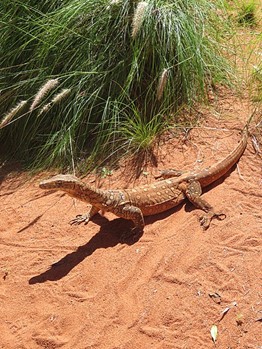 Source: Wikimedia
Source: Wikimedia
The perentie lizard, of which the Komodo dragon is a close cousin, is native to Australia. Although though the perentie lizard’s bite does not contain venom, the wound it causes might take a very long time to heal. The lizard does have the evolutionary remnants of a venom gland, which may be one of the reasons why the wound takes so long to heal once it has been punctured.
Their preferred foods are turtle eggs, insects, birds, other reptiles, small mammals, and marsupials. They also eat other small mammals and marsupials. The Perentie Lizard may live up to 40 years in the wild and can grow to be 8.2 feet long and weigh an average of 44 pounds. It goes into hibernation during the cooler months.
Did You Know?
The perentie will lift its head and hiss if it is confronted by a predator, which is intended to frighten the predator away. Their long tail may also be used as a whip, which is their second line of defense. If nothing of these solutions succeeds, they will abandon the fight and flee.
-
Tree Crocodile
Average Length: 9 feet
Average Weight: 31 pounds
Estimated Lifespan: 70 years
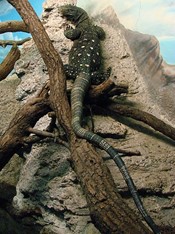 Source: Wikimedia
Source: Wikimedia
While the average length of a tree crocodile is between 7 and 9 feet, the record for the longest tree crocodile is an astounding 16 feet, earning them the title of longest reptile. The Komodo is still the largest by average size.
The tail of the lizard is the longest part of the animal and accounts for almost half of its total length. They particularly like eating dead animals, eggs of birds, and tiny reptiles and mammals.
Many are snared in traps that were originally intended for other species of animals. The monitor lizard’s tongue is shaped like a snake’s, which gives it more precision when it comes to hunting prey.
Did You Know?
Because of the aggressive nature, it is regarded to be one of the most difficult animals to hunt. On the other hand, its flesh and skin are precious commodities that may be used to make clothes and drumheads.
-
Water Monitor
Average Length: 10 feet
Average Weight: 110 pounds
Estimated Lifespan: 25 years
 Source: Wikimedia
Source: Wikimedia
The Malayan water monitor may be found in Southeast Asian countries. This vicious lizard can reach a length of 9.8 feet in length, is able to swim underwater for extended periods of time, and thrives on crabs and other crustaceans for food.
It is also able to climb trees and eat anything it finds in a bird’s nest when it gets there. They are not afraid of people and have been seen in metropolitan areas devouring dead animals found on the road.
The neck and the tail are rather lengthy, and both the claws and the tail have sharp points that may be used as weapons. If a human is bitten by a Malayan water monitor, they won’t die from the venom, but they will feel some moderate consequences from the poison and germs that came from the bite.
Did You Know?
The male guards will engage in wrestling. They do this by standing on their hind legs, and when they engage in combat, it seems like they are embracing each other. The contest is done and the winner is whomever is still standing after both competitors have been knocked to the ground.
-
Komodo Dragon
Average Length: 193 pounds
Average Weight: 150 pounds
Estimated Lifespan: 30 years
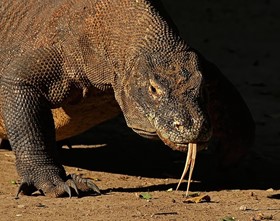 Source: Wikimedia
Source: Wikimedia
The Komodo dragon is the largest lizard in the world. It has an average length of 10 feet, a weight of 300 pounds, and a ranking as number one. The baby dragons have a length of 48 centimeters and spend the first several months of their lives on the branches of trees.
Mature Komodo dragons will consume their own young as well as the young of other dragon species, although carrion is their major source of nutrition. Pigs, deer, and cattle are sometimes part of their diet as well. It has been said that they will attack people and consume them.
Several people are under the impression that the bite also spreads germs, which speeds up the death process. Komodo dragons will also consume prey that has just passed away or is close to passing away as a source of food. The country of Indonesia is home to these animals.
Did You Know?
It is not always necessary for the Komodo dragon to successfully catch its prey. Its bite hinders the formation of blood clots, which causes their victim to fall into shock as they slowly bleed to death.
RELATED READINGS
15 Largest Reptiles in the World
7 Largest Turtle Species In The World (By Weight)
5 Largest Crocodiles in the World
